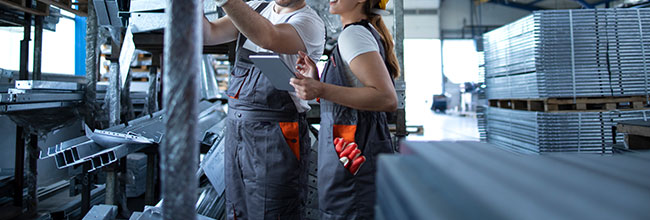Asbestos Exposure and Welders: Risk and Prevention
Welders have a difficult job, and one that is often rife with risk.
For decades, that has included asbestos exposure.
Even in the course of ordinary operations, welders can be exposed to a wide range of physical hazards. Accidents are common, and injuries can be life-altering.
However, welders—whether retired or working—face threats that are not always easy to ascertain, let alone mitigate.
!
If you believe that you were exposed to asbestos, even as a child, speak to a healthcare provider about tests and screening to help diagnose lung-scarring and screen for asbestos-related diseases.
For decades, welders across the country were expected to work with asbestos-containing materials. Asbestos, a type of naturally occurring mineral, was seen as a convenient and inexpensive solution to the demands of heavy industry. It was used to reinforce welding rods, fireproof buildings, and insulate equipment.
While scientists began investigating claims that asbestos could significant respiratory distress as early as the 1920s, the powerful asbestos lobby fought back, using its money and influence to silence researchers and sway federal regulators.
“The overall evidence suggests there is no safe level of asbestos exposure.”Source: National Cancer Institute (NIH)1 |
Asbestos is a carcinogen, and poses many ongoing health risks.
We know today that asbestos, for all of its supposedly “miraculous” properties, exacts a heavy toll—a toll that far outweighs its advantages. As rates of asbestos-related illness began to rise after the end of the Second World War, the federal government was finally forced to take action.
Yet, in spite of the Environmental Protection Agency’s decades-long drive to curtail the sale and import of asbestos-containing materials, contamination remains a widespread source of concern. Asbestos can still be found in tens of millions of American homes, offices, and worksites, posing a dire threat not only to welders but their families, too.
“Some asbestos fibers may bypass…your body’s natural defenses…and lodge deep within your lungs. Those fibers can remain in place for a very long time and may never be removed.”Source: American Lung Association |
The Rise of Industrial Welding and the Powerful Asbestos Industry
People around the world have employed different welding techniques since time immemorial. However, ancient and medieval methods of welding were fairly primitive, often involving repeated applications of heat and sheer physical strength.
While more modern methods of welding began to emerge at the end of the 19th century, the industry underwent a veritable revolution in the early 1900s. During the First World War, the American government initiated the mass production of armored naval ships, tanks, and other heavy vehicles. Welders, facing unprecedent demand for their skills and experience, started to experiment with new gas and electric rods, which helped them ply their trade more efficiently than ever before.
 |
| Nearly every building constructed before the mid-1980s contained asbestos products and building materials. |
 |
Many worksites where welders were employed contained asbestos.
Even after the war ended, welders remained in high demand, working in occupations including, but not limited to, the following:
• Automotive assembly
• Aviation
• Bridge building
• Construction
• Military
• Shipbuilding
The invention and expansion of novel welding techniques coincided, to no small extent, with the rapid-paced growth of the asbestos mining industry.
“All forms of asbestos are carcinogenic to humans.” 2

The Understated Dangers of Asbestos-Containing Welding Equipment
Since asbestos can be repurposed as a fire retardant and electrical insulator, businesses began purchasing asbestos-containing materials in bulk. Many of these materials were used—at least in theory—to make welders’ jobs easier and safer.
Asbestos has no taste or smell.
You may not know you’re breathing it.

On some worksites, welders were effectively required to use a variety of asbestos-containing tools, equipment, and clothing, including the following:
Asbestos Welding Aprons
Asbestos aprons were most likely invented in 1883 by Munich-based Metzler & Co., a rubber works company in what is today Germany.
By mixing asbestos fabric with natural rubber, Metzler & Co. created aprons that could protect workers from:
• Extreme heat
• Molten metal
• Fire-related injuries
While asbestos aprons originated in Germany, they were soon sold—and, eventually, manufactured—in dozens of countries, including the United States.
Several health studies have shown that the spouses of asbestos workers are at an elevated level of risk for asbestos illnesses like lung cancer.3 4 5 6
Asbestos Welding Blankets
Asbestos welding blankets were originally designed as safety devices. They were usually kept in close proximity to places with recognized fire hazards, including welding worksites.
Since asbestos is a flame retardant, asbestos-containing blankets could be thrown over small fires, depriving the flames of oxygen and preventing conflagrations from spreading to other areas.
Asbestos Welding Gloves
Asbestos gloves, or asbestos mitts, were used in a variety of occupations: military machine-gunners were sometimes outfitted with asbestos gloves, which helped soldiers handle hot barrels and expended cartridges, while welders wore them to perform routine industrial tasks.
Researchers believe that the limited use of asbestos mitts posed little risk to workers. However, when asbestos gloves began to degrade or fall apart, they could become friable, emitting small and invisible clouds of microscopic asbestos fiber.
Asbestos Welding Rods
Since every type of asbestos is heat-resistant, companies would sometimes coat welding rods with an insulating layer of asbestos-containing material.
While asbestos was an effective insulator that could prevent welding rods from overheating or catching on fire, the regular use of such rods could—over time—dislodge significant collections of asbestos fiber. These fibrous strands would separate from the rod, lingering in the environment and posing a serious inhalation risk to welders and other persons sharing the same workspace.
Smokers exposed to asbestos are up to 50 times more likely to develop lung cancer than nonsmokers who aren’t exposed.7 |
Contemporary Asbestos Exposure Risks for Modern-Day Welders
Even welders who never used asbestos-containing equipment were still exposed to asbestos, especially if and when they were expected to work with other asbestos-based materials.
While the federal Environmental Protection Agency banned most asbestos-containing materials in 1989, the government never ordered asbestos manufacturers to recall their products or undertake abatement on contaminated properties.
Many products and work materials and tools contained asbestos.
An estimated 30 million American homes still contain significant concentrations of asbestos, which could be found in the following types of products:
• Attic and wall insulation
• Boiler ducts
• Carpet underlays
• Concrete compounds
• Furnaces
• Heat-resistant fabrics
• Heat-resistant insulation and tape
• Patching compounds
• Textured paint
• Vinyl floor tiles
The health risks of asbestos exposure can include:
| Mesothelioma: cancer of the mesothelium, the thin layer of tissue surrounding the body’s organs. This cancer is only known to be caused by asbestos exposure. | Lung cancer |
| Laryngeal cancer: cancer of the larynx (section of the throat called the voicebox) | Ovarian cancer |
| Stomach cancer | Colon cancer |
| Pharyngeal cancer | Asbestosis: a chronic lung disease associated with asbestos exposure |
| Chronic Obstructive Pulmonary Disease (COPD) | Atelectasis (collapsed lung) |
| Pleural effusion (collection of fluid around the lungs) | Pericardial effusion (collection of fluid around the heart) |
The Devastating Effects of Asbestos Exposure
Asbestos exposure can take the following forms:
• Occupational asbestos exposure: Occupational asbestos exposure, or asbestos exposure that takes place at work, is the most common type of asbestos exposure. Most people who have been diagnosed with serious asbestos-related illnesses were exposed to asbestos on the job.
• Secondary asbestos exposure: Secondary asbestos exposure, or take-home asbestos exposure, occurs when a person employed in an asbestos-contaminated workplace inadvertently tracks asbestos back to their place of residence. Take-home asbestos exposure can affect asbestos workers, their spouses, and their children.
• Environmental asbestos exposure: Environmental asbestos exposure occurs when asbestos is present in the soil, water, or air. Since asbestos deposits can be found across the United States, almost everyone could be exposed to natural asbestos. However, the current or historical presence of asbestos-related industries in a community can increase the risk of disease for residents who have never worked with or around the mineral.
People who worked in these industries prior the mid-1980s have a higher risk of developing asbestos-related diseases:
| Construction | Factories | Foundries | Refineries | Shipyards | Mining / Milling |
| Demolition | Insulation | Steelworkers | Pipe Fitting | Shipbuilding | Mechanics |
 |  |  | |||
| Roofing | Textiles | Iron workers | Boilers | Firefighting | Brake Repair |
| Flooring | Cement | Electricians | Gasket Repair | Railroad | HVAC |
Unfortunately so do their families.
Asbestos exposure: an ongoing problem
Asbestos exposure does not discriminate, and scientists believe that no level of asbestos exposure is safe. It is associated with a wide range of illnesses, up to and including cancer.
Asbestos-related illnesses include, but are not limited to, the following:
• Asbestosis, a respiratory disease that affects the lungs. Asbestosis caused by the inhalation of asbestos fibers, which irritate the membranous lining of the lungs and chest cavity.
• Cancer, including cancers of the lungs, larynx, and ovaries.
• Chronic obstructive pulmonary disease, often abbreviated to COPD. Chronic obstructive pulmonary disorder is characterized by obstructive inflammation. People with COPD may experience difficulty breathing and performing routine tasks.
• Mesothelioma, an unusually aggressive type of cancer that is most often caused by asbestos exposure. Most people who have mesothelioma are victims of occupational asbestos exposure or second-hand asbestos exposure.
• Pleural disease, which could include the development pleural plaques and pleural effusions.
Most asbestos-related diseases have long latency periods, or latent period. A latency period is the time it takes for an infection or disorder to begin exhibiting noticeable symptoms.
“Generally, those who develop asbestos-related diseases show no signs of illness for a long time after exposure.”Source: National Cancer Institute (NIH)9 |
The Latency Period: Asbestos-related diseases can take 20-50 years to appear.
Since asbestos-related illnesses like mesothelioma can have decades-long latency periods, many former asbestos workers never know that their body is harboring a potentially life-threatening disease until they receive a diagnosis.
Sharing a home or vehicle with someone wearing asbestos-tainted clothing puts you at risk of asbestos-related diseases. 10
How Welders Affected By Asbestos Can Protect Their Rights After a Life-Changing Diagnosis
Some asbestos-related illnesses, like asbestosis and pleural disease, are not necessarily life-threatening.
Unfortunately, conditions like pleural disease are often indicative of more serious medical issues.
By the time that a family doctor can detect or diagnose a more malignant asbestos-related disease, it is often too late for physicians to order any curative treatment. Even when victims have a fighting chance, the costs of recovery could seem insurmountable.
However, many welders affected by asbestos-related illnesses have options beyond recovery. Since the federal government began taking action against the asbestos industry, courts across the country have upheld the rights of Americans to recover damages from negligent corporations and reckless employers.
Do You Qualify For Compensation?
Quickly and easily find out how you were exposed by searching W.A.R.D., the largest asbestos database on the planet.
FREE SEARCH >If you, or a loved one, have been injured by asbestos, you could be entitled to significant compensation through:
• A personal injury lawsuit. A personal injury lawsuit is a type of civil claim filed against a person, or party, whose negligence resulted in significant injury. Contrary to popular misconception, most personal injury lawsuits are settled out-of-court, without the need for trial.
• An asbestos bankruptcy trust. Between the 1980s and early 2000s, dozens of asbestos companies were ordered to create dedicated trust funds. These trusts have set aside billions of dollars for people injured by negligent corporate practices. While asbestos bankruptcy trusts have already distributed more than $20 billion benefits, many trusts remain operational, holding an estimated $30 billion in additional unclaimed compensation.
Over $30 Billion is still available (No lawsuit. No fees unless you receive money. No risk.) Stake your claim.  |
• A FELA claim. The Federal Employers Liability Act, or FELA, defines significant legal protections for railroad workers who were injured on the job. FELA claims can provide compensation for a variety of railway-related injuries, including exposure to asbestos and other toxins.
AsbestosClaims.Law
Asbestos claims aren’t just a day in the office for Justinian C. Lane.
They’re a mission.
In the past, workers exposed to asbestos were kept in the dark about the dangers of asbestos exposure. Among those workers were Justinian’s grandparents and his own father.
Unfortunately, they were also kept in the dark about the compensation options available to them, such as asbestos lawsuits and trust funds. In their later years, they died from asbestos-related cancers.
Because no one in Justinian’s family knew their options, they never received any compensation for the death of their loved ones.
Today, we’re working to turn the tide.
Significant compensation may be available to you if you have contracted an asbestos-related illness or injury. This includes workers as well as family members who have been exposed.
Compensation is your key to receiving the medical treatment you need, funding asbestos removal services, and maintaining your physical well-being.
Want to know one of the quickest and easiest ways to receive compensation? Let us talk to you about asbestos trust claims. This option can often avoid lawsuits altogether.
We want to hear your story, and more importantly, we want to bring redemption to it.
Need help filing a claim? No problem, you can email us at [email protected].
Would you rather talk over the phone? Simply call or text us, at (206) 455-9190.
You won’t pay a penny to us unless you receive money first, so there’s no risk.
In addition to legal claims, veterans disability, social security and employment protection like workers compensation, FELA and The Jones Act for maritime workers, there are asbestos trusts that have been set up to compensate those harmed by asbestos without having to file a lawsuit.
The dangers of asbestos used to be an industry-guarded secret kept from suffering people like Justinian’s family. Not anymore. We’re bringing you the truth.
We’ve created numerous resources to help answer your questions and empower you with the information you need to know and act on.
Our website has a wealth of information dedicated to things like health and safety, asbestos testing, asbestos removal, and legal information about compensation for asbestos injuries.
Are you a visual learner? No problem!
Our YouTube page has infographics, an asbestos history series, and other helpful resources for you to check out!
| Not sure where or when you were exposed to asbestos? Let W.A.R.D. help you! The Worldwide Asbestos Research Database (W.A.R.D) is the largest asbestos information database, period. If you need answers related to specific locations, products, or what type of compensation may be available to you due to asbestos exposure, W.A.R.D. is the place to start. |
Working with us is risk-free. Unless you receive compensation money, there are NO FEES! Speak to us about asbestos litigation today.
1 National Cancer Institute (NIH), Asbestos Fact Sheet.
2 IARC Working Group on the Evaluation of Carcinogenic Risks to Humans. Arsenic, metals, fibres, and dusts. IARC Monographs on the Evaluation of Carcinogenic Risks to Humans. 2012 ;100(Pt C):11-465. PMID: 23189751.
3 Ferrante, D., Bertolotti, M., Todesco, A., Mirabelli, D., Terracini, B. and Magnani, C., 2007. Cancer mortality and incidence of mesothelioma in a cohort of wives of asbestos workers in Casale Monferrato, Italy. Environmental Health Perspectives, 115(10), pp.1401-1405.
4 Miller, A., 2005. Mesothelioma in household members of asbestos‐exposed workers: 32 United States cases since 1990. American journal of industrial medicine, 47(5), pp.458-462.
5 Reid, A., Heyworth, J., De Klerk, N. and Musk, A.W., 2008. The mortality of women exposed environmentally and domestically to blue asbestos at Wittenoom, Western Australia. Occupational and environmental medicine, 65(11), pp.743-749.
6 İşten, B.H.S.T.O. and Maruziyetler, E.T., 2021. Exposures Moved from Work to Home as a Public Health Hazard.
7 Klebe, S., Leigh, J., Henderson, D.W. and Nurminen, M., 2020. Asbestos, smoking and lung cancer: an update. International journal of environmental research and public health, 17(1), p.258.
8 Klebe, S., Leigh, J., Henderson, D.W. and Nurminen, M., 2020. Asbestos, smoking and lung cancer: an update. International journal of environmental research and public health, 17(1), p.258.
9 National Cancer Institute (NIH), Asbestos Fact Sheet.
10 Anua, S.M., Semple, S., Shakri, S.F.M., Safuan, S., Mazlan, N. and Asri, A.A.M., 2019. A review of the take-home exposure pathway of workplace hazards. International Journal of Medical Toxicology & Legal Medicine, 22(3and4), pp.13-19.